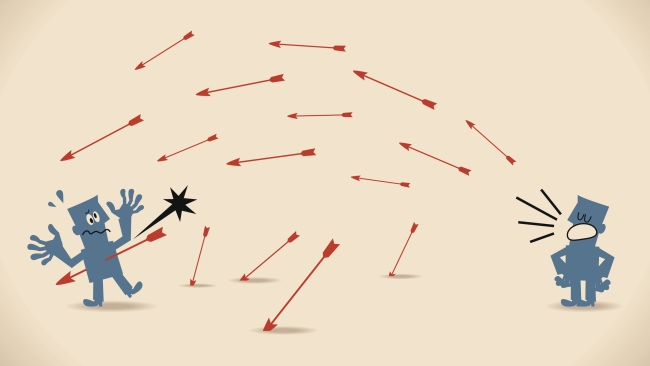You have /5 articles left.
Sign up for a free account or log in.

iStock
What makes someone racist? Is what they say at all indicative of that, or can it be brushed away as a one-off mistake or misperception?
Take, for example, the 2016 presidential election, where leaders from both sides struggled to call Donald Trump an outright racist, even if they insisted some of his remarks were.
“I’m not saying what’s in his heart because I don’t know what is in his heart, and I don’t think he feels that in his heart,” Speaker of the House Paul Ryan said after Donald Trump attacked an American-born judge of Mexican heritage for harboring a supposed bias against him, based on that heritage. “But I don’t think it is wise or justifiable to suggest that a person should be disqualified from their job because of their ethnicity.”
While Trump’s comments on the judge were overtly racist -- with Ryan, a member of Trump’s party, calling them the “textbook definition of a racist comment” -- assessing whether someone is personally “actually racist” has proved to be almost impossible. Much of the same thinking goes into the way critics debate the substance of microaggressions, the subtle remarks that people of color find offensive but that might be delivered without intentional malice. Even if a microaggression is racist -- which is often up for debate itself -- critics often say the person delivering it isn’t, and those offended by it are being too sensitive.
But a new study backs up those who speak out against microaggressions and questions the attitudes of the people that deliver them.
The study, published in the journal Race and Social Problems, defines microaggressions as “brief and commonplace daily verbal, behavioral and environmental indignities, whether intentional or unintentional, that communicate hostile, derogatory or negative racial slights and insults to the target person or group.” Focusing on those who use microaggressions, rather than those who are on the receiving end, the study found a positive correlation between uttering microaggressions and harboring racist attitudes.
“Results offer preliminary support that the delivery of microaggressions by white students is not simply innocuous behavior and may be indicative of broad, complex and negative racial attitudes and explicit underlying hostility and negative feelings toward black students,” researchers wrote in “A Preliminary Report on the Relationship Between Microaggressions Against Black People and Racism Among White College Students.”
Researchers surveyed 33 black students at a large public university located in the “Southern/Midwest” United States, asking them to assess phrases and scenarios that they would consider microaggressions. Then, 118 white, non-Hispanic students answered how likely they were to say those same microaggressions.
Examples and scenarios given to white students and assessed by black students were tailored specifically to anti-black racism, and included asking a black law student if he got into school on a diversity scholarship, calling him “a credit to [his] race” and being surprised he is a law student. Other examples focused on black women, using the N-word when singing a song that uses it, white privilege and policing.
The white students were also assessed in various ways to measure their attitudes toward black people, using metrics including the Feeling Thermometer, the Allophilia Scale, the Symbolic Racism Scale 2000, the Color-Blind Racial Attitudes Scale and the Modern Racism Scale. Researchers found a correlation suggesting that uttering a microaggression is, on average, related to harboring racist attitudes as well:
White students who reported that they were more likely to microaggress were more likely to endorse color-blind, symbolic and modern racist attitudes, report significantly less favorable attitudes toward black people on the feeling thermometer, and report significantly less positive attitudes toward black people. These findings provide empirical support that microaggressive acts are rooted in racist beliefs and feelings of deliverers, and may not be dismissed as simply subjective perceptions of the target.
Jonathan Kanter, an associate professor of psychology at the University of Washington and the lead author of the study, said that the study provides validation for people of color who often have to work to prove that microaggressions are offensive in the first place.
“Our understanding of the nature of racism is developing,” he said. “There’s clear evidence that over the past 50 years, acts of overt racism have decreased … More subtle forms of racism -- indirect racism, implicit biases that show up in everyday biases -- have become more of a focus.”
“It’s absolutely clear that microaggressions are an issue, and not just [because of] my study. And what our study does is it offers an important validation for the experience of people of color. They’re not ‘just being too sensitive’ when they report the experience of a microaggression.”
Kanter also said that his study can help explain the pushback from those who say microaggressions aren’t a problem, aren’t racist or don’t matter because they aren’t intentional.
“I think many white people get defensive when accused of engaging in a microaggression,” he said. “And that defensiveness makes sense, because they were not intending to be racist or hurtful with what they were saying … However, what our study shows is it’s not crazy or even unreasonable for the person of color to be offended by those comments.”
Indeed, Kanter said, the people who make those comments tend to rank higher on measures of racism. Additionally, because microaggressions happen on a case-by-case basis, a white person who makes one might rank low on other racism scales, which would give credit to their claim of not trying to be offensive, but also possibly add to their confusion or pushback against microaggressions being a problem at all.
“They get defensive, but it’s reasonable for the person of color being offended,” Kanter said, especially since the average person who might make that comment would measure higher on scales examining racism and racist attitudes.
Ultimately, Kanter said, the research can serve as a jumping-off point, since more data are needed. The survey is limited by its size and the region of the U.S. it was conducted in, as well as the group it applies to -- the LGBT community and Latino/Latina students would also be good groups to tailor surveys to, he said. Still, he said, the results have broad applications.
“The results weren’t all that surprising,” he said. “I don’t suspect it’ll be different across regions in the United States, but we do have to wait to see how that plays out.”
Additionally, Kanter hopes the research will help keep the conversation about microaggressions and their implications in the spotlight.
“I do think it’s timely and important, especially given the kickback against microaggressions and microaggression training programs. I do think it’s important for people to know that microaggressions are not just people of color being too sensitive: that’s an offensive and microaggressive and racist thing to say in and of itself,” he said. “There are some calls for a moratorium on campus-based microaggression [sensitivity] training programs, because of the debate right now that somehow these programs are actually doing harm instead of actually helping. The science at the moment -- and not just my study -- is actually saying that’s a deeply troubling suggestion.”








